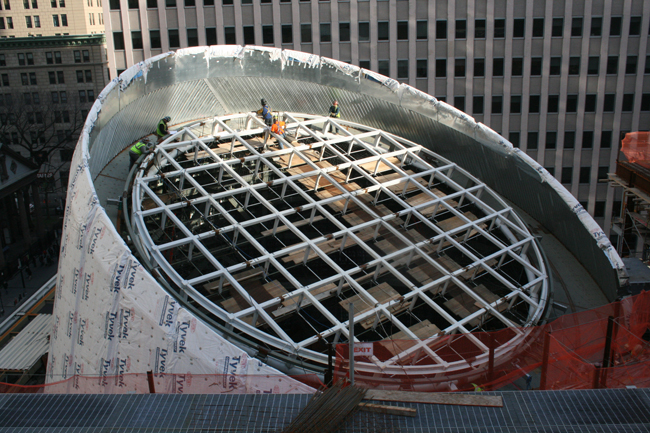
BY ALINE REYNOLDS | Fifty feet below the frenzied street activity of Lower Manhattan, dozens of workers are busily setting rebar, connecting pipes and digging large holes in the earth.
Above ground and visible from street level, meanwhile, other workers are sculpting a soon-to-be skylight that will funnel natural light all the way down to where their co-workers are.
The construction crew is paving the way for the new, Fulton Street Transit Center, which, once completed in 2014, will connect 11 subway lines and the PATH station in addition to offering 70,000 square feet of new retail. The transit hub will also supply an underground passageway that will link the World Financial Center with William Street — one of several amenities that promises to streamline workers’ daily commutes and tourists’ journeys around Downtown, according to Uday Durg, senior vice president and program executive for the Metropolitan Transit Authority’s Lower Manhattan projects.
“We want to make sure that people don’t just come here to transfer [between] stations,” said Durg as led a tour around the construction site last week. “We’re trying to create a great civic space and a great public space.”
Indeed, the transit center will comprise two floors of shops and restaurants which, accessible by a spiral staircase and elevators, will offer direct views of St. Paul’s Chapel and Broadway. The building’s 53-foot wide oculus was specially designed to track the earth’s rotation around the sun, according to Durg. Once the oculus’ glass panels are installed next summer, prismatic solar reflectors will be attached to a diamond-shaped cable net that will warp inside a stainless steel dome.
“When [commuters] see light, they’ll feel less claustrophobic; and the second thing is, light is very good for orientation,” said Durg.
The transit center also promises to achieve L.E.E.D. (Leadership in Energy and Environmental Design) certification and be fully accessible to the disabled population. It boasts digital wayfinding and notification signage utilizing L.C.D. screens and electronic strips. The goal, Uday explained, is to help straphangers decide which train to take before they reach the platform.
“When you know where you’re going, you walk faster,” said Durg. “I don’t want to walk three blocks down and find out that the 2 train isn’t running.”
Construction of the $1.4 billion transit center came to a near halt in the mid-2000s, when the project fell short of funding. “We broke up the project into six different contracts, and we got one very high bid of $870 million — twice the estimate that we had,” explained Durg. In 2009, the project was subsequently salvaged by $423 million in federal stimulus grants.
One year later, the M.T.A. accomplished one of the project’s greatest feats, which was to stabilize the 19th century Corbin Building that had been heavily damaged by the 9/11 attacks.
“That kept me awake every single day,” recalled Durg, who closely monitored the building using a digital system he compared to electrocardiography (E.K.G.). “It’s something we were always very worried about because the soil in Lower Manhattan is so mushy and liquefied.”
The Corbin Building will open to the public in 2014, along with the rest of the transit center; the M.T.A. will be issuing a Request for Proposal as soon as this spring to find tenants, according to Durg. A new set of escalators inside the building, meanwhile, will bring subway riders from the concourse level of the Dey Street 4/5 train to John Street.
Other aspects of the project have proven difficult, such as mediating between the multiple contractors, Durg noted. “One of the biggest challenges is coordinating all the work to make sure that, if this guy doesn’t finish on time, the other guy has to stop,” he said.
One problem Durg and his crew couldn’t solve was figuring out how to connect the east and west sides of the A/C mezzanine, which is divided by the J and Z subway tracks.
“There’s nothing we can do about it now,” said Durg’s administrative assistant and right-hand man, Justin Schultz. “We can’t move the tracks.”
The M.T.A. reopened the Cortlandt Street R train northbound platform in late 2009 and the R’s southbound platform last September. As passengers walk through the newly constructed concourse connecting the platforms, they can stop and gaze at “Trade, Treasure and Travel,” artist Margie Hughto’s decorative ceramic tiles that harken back to trading activity in and out of Lower Manhattan.
“Almost all of them were unscathed during the attacks, which was really amazing, since there was so much damage to that station,” said Schultz.
But that’s not all the artwork on display: Murals amassed from the former Hotel McAlpin near Penn Station line the walls of the A/C station’s eastern mezzanine level, depicting ships, gems, sea creatures and other components of the city’s maritime history. The M.T.A. also took possession of a cast-iron gate from the former Marine Grill, the hotel’s restaurant, which stands inside the William Street entrance to the 2/3 and A/C lines. While the gate grill is a work of art, it also functions to separate one side of the station’s turnstile area from the other, Schultz explained.
Asked about the most exciting aspect of the project, Schultz replied, “I think, seeing something get built that’s going to be around and in use for tons of people for the next 100 years.”
Next in line to open will be the Dey Steet entrance to the 4/5 trains and the corresponding concourse.
“That’ll be a big milestone for us,” said Schultz, “because it’ll allow people to go from the Cortlandt Street R train to the 4/5 station underground for the first time. Obviously, meeting that goal is going to be a lot of work.”
“It has been a long, torturous road for me,” chimed in Durg. “I started this project in 2002, and I’m still here. After so many years, I see that, finally, everything is coming together.”


































